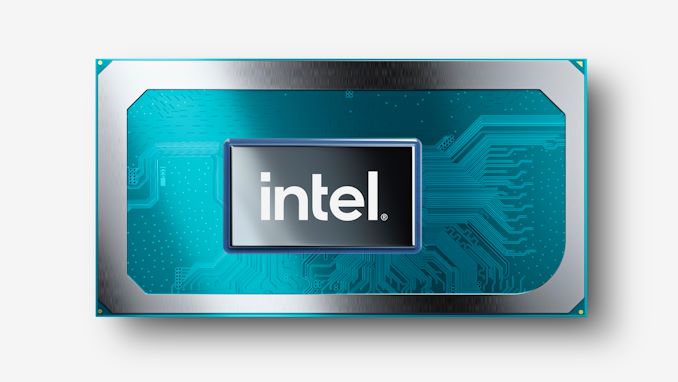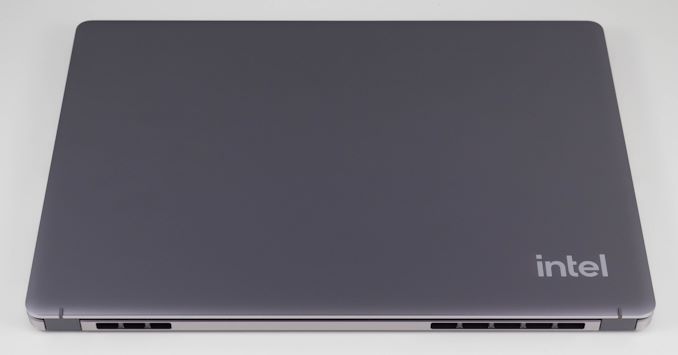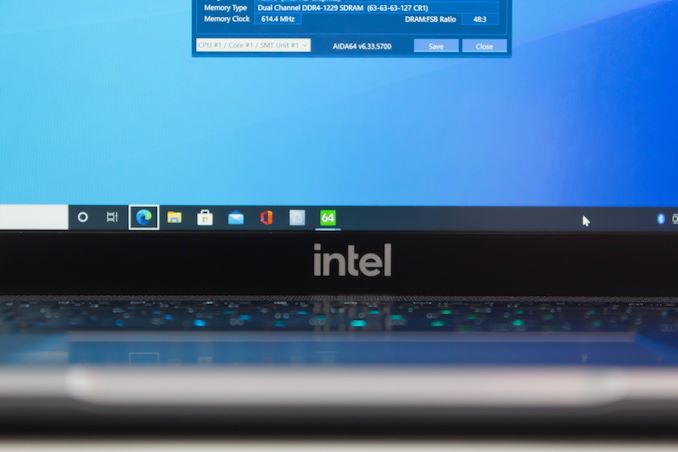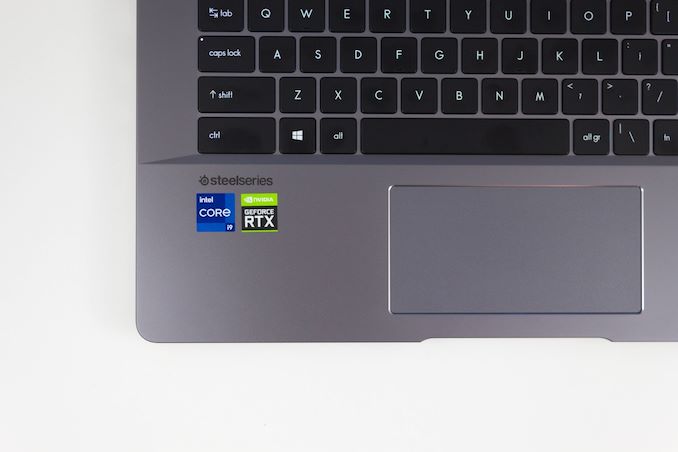Intel 11th Generation Core Tiger Lake-H Performance Review: Fast and Power Hungry
by Brett Howse & Andrei Frumusanu on May 17, 2021 9:00 AM EST- Posted in
- CPUs
- Intel
- 10nm
- Willow Cove
- SuperFin
- 11th Gen
- Tiger Lake-H

Last week Intel launched their Tiger Lake-H family of laptop processors. Aimed at the larger 14-inch and above laptops, this processor family is Intel’s newest offering for the high-performance laptop market, stepping in above Intel’s mobility-focused U and Y series of chips. Based on the same Tiger Lake architecture that we first became familiar with last year, Tiger Lake-H is bigger and better (at least where the CPU is concerned), offering up to 8 CPU cores and other benefits like additional PCIe lanes. Overall, Intel’s H-series chips have long served as the performance backbone of their laptop efforts, and with Tiger Lake-H they are looking to continue that tradition.
While last week was Tiger Lake-H’s official launch, as has become increasingly common for laptop launches, the embargoes for the launch information and for hardware reviews have landed on separate dates. So, while we were able to take about the platform last week, it’s only today that we’re able to share with you our data on TGL-H – and our evaluation on whether it lives up to Intel’s claims as well as how it stacks up to the competition.
Like Intel’s other laptop chips, Tiger Lake-H has multiple facets, with the company needing to balance CPU performance, GPU performance, and power consumption, all while ensuring it’s suitable to manufacture on Intel’s revised 10nm “SuperFin” process. Balancing all of these elements is a challenge in and of itself, never mind the fact that arch-rival AMD is looking to compete with their own Zen 3 architecture-based Ryzen 5000 Mobile (Cezanne) APUs.
| Intel Tiger Lake-H Consumer | ||||||||||
| AnandTech | Cores Threads |
35W Base |
45W Base |
65W Base |
2C Turbo |
4C Turbo |
nT Turbo |
L3 Cache |
Xe GPU |
Xe MHz |
| i9-11980HK | 8C/16T | - | 2.6 | 3.3 | 5.0* | 4.9 | 4.5 | 24 MB | 32 | 1450 |
| i9-11900H | 8C/16T | 2.1 | 2.5 | - | 4.9* | 4.8 | 4.4 | 24 MB | 32 | 1450 |
| i7-11800H | 8C/16T | 1.9 | 2.3 | - | 4.6 | 4.5 | 4.2 | 24 MB | 32 | 1450 |
| i5-11400H | 6C/12T | 2.2 | 2.7 | - | 4.5 | 4.3 | 4.1 | 12 MB | 16 | 1450 |
| i5-11260H | 6C/12T | 2.1 | 2.6 | - | 4.4 | 4.2 | 4.0 | 12 MB | 16 | 1400 |
| *Turbo Boost Max 3.0 | ||||||||||
Intel’s Reference Design Laptop: Core i9-11980HK Inside
For our Tiger Lake-H performance review, Intel has once again sent over one of their reference design laptops. As with the Tiger Lake-U launch last year, these reference design laptops are not retail laptops in and of themselves, but more of an advanced engineering sample designed to demonstrate the performance of the underlying hardware. In this specific case, the BIOS identifies that the laptop was assembled by MSI.
Wanting to put their best foot forward in terms of laptop performance, Intel’s TGL-H reference design laptop is, as you’d imagine, a rather high-end system. The 16-inch laptop is based around Intel’s best TGL-H part, the Core i9-11980HK, which offers 8 Willow Cove architecture CPU cores with SMT, for a total of 16 threads. This processor can turbo as high as 5.0GHz on its favored cores, a bit behind Intel’s previous-generation Comet Lake-H CPUs, but keeping clockspeeds close while making up the difference on IPC.
Unfortunately, their desire to put their best foot forward means that Intel has configured the CPU in this system to run at 65W, rather than the more typical 45W TDP of most high-end laptops. 65W is a valid mode for this chip, so strictly speaking Intel isn’t juicing the chip, but the bulk of the Tiger Lake-H lineup is intended to run at a more lap-friendly 45W. This gives the Intel system an innate advantage in terms of performance, since it has more TDP headroom to play with.
| Intel Reference Design: Tiger Lake-H | |
| CPU | Intel Core i9-11980HK 8 Cores, 16 Threads 2600 MHz Base (45W) 3300 MHz Base (65W) 5000 MHz Turbo 2C 4500 MHz Turbo nT |
| GPU | Integrated: Xe-LP Graphics 32 Execution Units, up to 1450 MHz Discrete: NVIDIA GeForce RTX 3060 Laptop 30 SMs, up to 1703MHz |
| DRAM | 32 GB DDR4-3200 CL22 |
| Storage | 2x OEM Phison E16 512GB SSD (NVMe PCIe 4.0 x4) |
| Display | 16-inch 2560x1600 |
| IO | 2x USB-C 2x USB-A |
| Wi-Fi | Intel AX210 Wi-Fi 6E + BT5.2 Adapter |
| Power Mode | 65 W (Mostly tested at 45W) |
Meanwhile the focus on CPU performance with TGL-H does come at a cost to integrated GPU performance. TGL-H parts include Intel’s Xe-LP GPU, but with only 32 EUs instead of the 96 found on high-end Tiger Lake-U systems. With TGL-H, Intel is expecting these systems to be bundled with discrete GPUs, so they don’t dedicate nearly as much die space to an integrated GPU that may not get used much anyhow. To that end, the reference system comes with an NVIDIA GeForce RTX 3060 Laptop graphics adapter as well, which is paired with its own 6GB of GDDR6.
Rounding out the package, the system comes with 32GB of DDR4-3200 installed. Storage is provided by a pair of Phison E16-based OEM drives, allowing Intel to show off the benefits of PCIe 4.0 connectivity for SSDs. Finally, Wi-Fi connectivity is also Intel-powered, using the company’s new AX210 adapter, which offers Wi-Fi 6E + BT5.2 on a single M.2 adapter. It’s worth noting that the AX210 is a fully discrete adapter, so it doesn’t leverage TGL-H’s integrated (CNVi) MAC, as that doesn’t support Wi-Fi 6E.
And, in keeping with making this reference system look as close to a retail design as reasonably possible, Intel even put the usual Intel Core and NVIDIA GeForce stickers on the laptop.
Unfortunately, we’ve had relatively little time with the system ahead of today’s embargo. The embargo on performance figures was originally scheduled for last Thursday (May 13th). However due to delays in shipping these laptops to reviewers, we didn’t receive the system until the end of last week, and Intel bumped back the embargo accordingly. So with just over two days to look over the system, we’ve really only had a chance to take a look at the most critical aspects of the system when it comes to performance.














229 Comments
View All Comments
Bagheera - Tuesday, May 18, 2021 - link
Intel isn't gonna have enough EUV in time to ramp 7nm by 2023. they are in serious trouble and floating on borrowed time, most analysts just aren't aware.https://semiwiki.com/forum/index.php?threads/will-...
Intel's 10nm is indeed competitive with TSMC 7nm in terms of density, but AMD will be moving to 5nm with Zen 4 next year, what can Intel's response be? They can increase outsourcing to TSMC but that means less utilization of their own fabs which is bad. They absolutely won't be able to get 7nm ready in time to compete with AMD on TSMC 5nm. It will be back to the status quo of Intel lagging behind AMD by one full node, and likely foregoing power efficiency for performance parity.
Bagheera - Tuesday, May 18, 2021 - link
no actual semiconductor professional expected Intel 10nm to surpass TSMC 7nm in any tangible way. the only people who expected otherwise are uniformed enthusiasts (usually gamers, who the to be partial to Intel)The gap will only widen from here. Intel really shot itself in the foot with bad EUV planning.
https://semiwiki.com/semiconductor-services/ic-kno...
watzupken - Tuesday, May 18, 2021 - link
I feel this review concludes that Intel have effectively lost their competitive edge when their fab started to lag behind. In fact, its also conclusive that the SuperFin is really nothing super at all even when compared to TSMC's 7nm. Its just 10nm on steroids just like what they have been doing to their 14nm. From an architect standpoint, Willow Cove is decent, but the bulk of the performance is due to pushing for very high clock speed at the expense of very high power consumption. If this was released on a desktop, it will be a hit. But on mobile, I don't think one can easily find a laptop that have the cooling capability to tame the heat output and also maintain a decent battery life. Especially this processor will likely be paired with a high end GPU. To me, this is a worrying trend for Intel because they will likely have to stick around with 10nm for another couple of years at least. If their new CPU architect is unable to provide decent IPC gains without bursting the power limit, they will surely be in trouble, especially when AMD's 5nm chips may appear in the market first.mode_13h - Tuesday, May 18, 2021 - link
> If this was released on a desktop, it will be a hit.Yes.
> I don't think one can easily find a laptop that have the cooling capability
> to tame the heat output and also maintain a decent battery life.
At 35 W, it would probably make a fine laptop. Unfortunately, competitive pressure is pushing Intel to juice their CPUs more than they really should.
sandeep_r_89 - Tuesday, May 18, 2021 - link
Can you please please stop using the word BIOS for modern devices? Pretty much all devices have been on UEFI only for several years now.Silver5urfer - Tuesday, May 18, 2021 - link
Ah the M1 fastest CPU ever, doesn't make it to SMT SPEC scores for some reason, like always. Don't worry we will see the Apple CPU which would be X version of the chip iteration when it finally catches up to the SMT of these SMT until then M1 is the best CPU ever.TGL machines will throttle to peak with the thin and light garbage heatsinks. That's a given, people should stop buying these parts. Laptop batteries will be destroyed eventually and none of them will have the Dell Desktop Power plan only Workstations have that feature (Lenovo and Dell), Alienware used to have, not sure about now their A51M R1 and R2 also they had their GFX modules smoke, anyways the battery won't be available for the end user to service and the expensive machine will die and BGA with soldered HW to further limit everything, add the overheating NVMe SSDs due to poor ventilation, happens in Alienware machines too which are targeted as maximum performance.
Spunjji - Thursday, May 20, 2021 - link
🤪🤡😤🤬🤥💩mode_13h - Friday, May 21, 2021 - link
Oof. Looks like *someone* is giving Emojipedia a workout!: )
Spunjji - Tuesday, May 18, 2021 - link
This ended up how I was expecting - superior single-core performance where there's thermal headroom, dropping down to broadly competitive multi-performance at the rated TDP, and with a faintly ludicrous maximum power draw under all-core boost.I'm glad it's competitive. That's needed. What I'm a little less glad about is that we're almost certainly in for another round of CPU performance varying *wildly* between different designs, which has been true to some extent for a while, but getting steadily worse ever since Ice Lake showed up.
Given most OEMs' approach to cooling, I'd wager that the average device shipping with Cezanne will provide better CPU performance than the average device with Tiger 45 simply because of Cezanne's greater efficiency.
tekit - Tuesday, May 18, 2021 - link
Heard they enabled undervolting again for tiger lake-h, can anyone confirm? I wonder how much undervolting potential there is and if that could balance the equation against AMD.